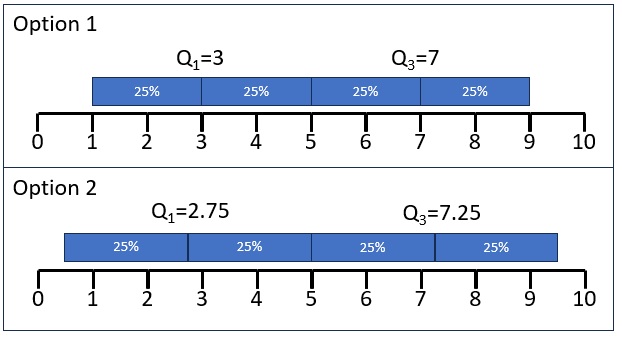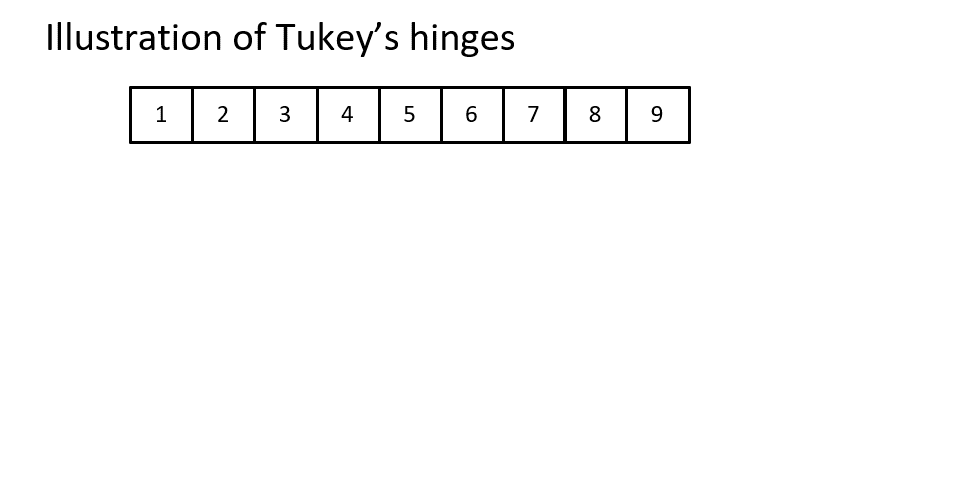Quantiles
Explanation
The median is the value in the middle of a sorted list of scores, i.e. the value for which 50% of the scores is equal or lower, and 50% in higher or lower. We could of course also split the data into four parts, each having 25% of the data. This results in the so-called quartiles.
A bit odd, but there are five quartiles. The 0th quartile is the minimum value, the 1st the value at 25%, the 2nd at 50% (equal to the median), the 3rd at 75%, and the 4th at the maximum (100%). One could argue about the 0th quartile being the minimum, alternative we could simply not define it. The term lower quartile and higher quartile (McAlister, 1879, p. 374) or upper quartile (Galton, 1881, p. 245) are also used for the first and third quartile.
Unlike with the median, there are a lot of different methods to go about this (in the formula section I've listed 20 of them). They have slightly different results, and for large sample sizes this will usually not have a big impact. Just to show one difference figure 1 illustrates two different methods to determine what the quartiles should be.
Figure 1Two options for quartiles for scores 1 to 9

Both options have the same median, but the quartiles are different. One special mentioning is the method from Tukey who didn't use the term quartiles but hinges (Tukey, 1977, p. 33). The approach from Tukey is illustrated in figure 2.
Figure 1Illustration of Tukey's Hinges

Quantiles (Kendall, 1940, p. 83) take the quartiles idea a step further and in essence just go for any percentage you want. If you divide by ranges of 20% you get quintiles (Fisher et al., 1922, p. 340), by 10% decentiles (Galton, 1881, p. 245), by 1% percentiles (Galton, 1885, p. 276), etc.
Obtaining the Measure
with Excel
Excel file: ME - Quartiles and Quantiles (E).xlsm
using stikpetE
without using stikpetE, using built-in functions
without using stikpetE, without built-in functions
without using stikpetE, for non-numerical data
with Python
Notebook: ME - Quartiles and Quantiles (P).ipynb
using stikpetP
without using stikpetP, using Pandas or Numpy
without using stikpetP, without 3rd party libraries
with R
Notebook from video: ME - Quartiles and Quantiles (R).ipynb
using stikpetR
without using stikpetR
without using stikpetR, all possible methods
with SPSS
Formula
For the inclusive method, the index of the first and third quartile can be found using:
\(i = \begin{cases} \frac{n+2}{4} & \text{ if } n \text{ mod } 2 = 0 \\ \frac{n+3}{4} & \text{ else } \end{cases}\)
\(i = \begin{cases} \frac{3\times n +2}{4} & \text{ if } n \text{ mod } 2 = 0 \\ \frac{3\times n+1}{4} & \text{ else } \end{cases}\)
For the exlusive method, the index of the first and third quartile can be found using:
\(i = \begin{cases} \frac{n+2}{4} & \text{ if } n \text{ mod } 2 = 0 \\ \frac{n + 1}{4} & \text{ else } \end{cases}\)
\(i = \begin{cases} \frac{3\times n +2}{4} & \text{ if } n \text{ mod } 2 = 0 \\ \frac{3\times n + 3}{4} & \text{ else } \end{cases}\)
The inclusive method could be found in Tukey (1977, p. 32), Siegel and Morgan (1996, p. 77) or Vining (1998, p. 44). Tukey referred to this as hinges, rather than quartiles. The exclusive method in Moore and McCabe (1989, p. 33) or Joarder and Firozzaman (2001, p. 88).
Others use a proportion of the data (\(p\)). These can then be used for any quantile. For a first quartile \(p = \frac{1}{4}\), and for a third quartile \(p = \frac{3}{4}\). The index of the quantile \(i\) can then be found in different ways, depending on your source.
| Label | i |
|---|---|
| SAS1 | \(n\times p\) |
| SAS4 | \(\left(n + 1\right)\times p\) |
| HL | \(n\times p + \frac{1}{2}\) |
| Excel | \(\left(n - 1\right)\times p + 1\) |
| HF8 | \(\left(n + \frac{1}{3}\right)\times p + \frac{1}{3}\) |
| HF9 | \(\left(n + \frac{1}{4}\right)\times p + \frac{3}{8}\) |
If the resulting index \(i\) is an integer there are two options:
- use that integer as index, i.e. \(Q_p = x_i\)
- use the midpoint between the score with that index and the next integer, i.e. \(Q_p = \frac{x_{i} + x_{i+1}}{2}\)
If the resulting index is not an integer there are a few different variations
- round down \(\lfloor\dots\rfloor\)
- round up \(\lceil\dots\rceil\)
- use bankers rounding \(\left<\dots\right>\)
- round to the nearest integer \(\left[\dots\right]\)
- round half always down, rest normal \(\lfloor\dots\rceil\)
- take the midpoint
- use linear interpolation
The midpoint can be calculated using:
\(Q_p = \frac{x_{\lfloor i\rfloor} + x_{\lceil i \rceil}}{2} \)
The linear interpolation uses
\(Q_p = \left(i - \lfloor i\rfloor \right)\times\left(x_{\lceil i \rceil} - x_{\lfloor i \rfloor} \right) + x_{\lfloor i \rfloor}\)
If the index is not an integer the method used can even change depending on if the requested quantile is above or below the median.
| method | indexing | i is int | p < 0.5 | p > 0.5 |
|---|---|---|---|---|
| sas1 | sas1 | use int | linear | linear |
| sas2 | sas1 | use int | bankers | bankers |
| sas3 | sas1 | use int | up | up |
| sas5 | sas1 | midpoint | up | up |
| hf3b | sas1 | use int | nearest | halfdown |
| sas4 | sas4 | use int | linear | linear |
| ms | sas4 | use int | nearest | halfdown |
| Lohninger | sas4 | use int | nearest | nearest |
| hl2 | hl | use int | linear | linear |
| hl1 | hl | use int | midpoint | midpoint |
| maple2 | hl | use int | down | down |
| excel | excel | use int | linear | linear |
| pd2 | excel | use int | down | down |
| pd3 | excel | use int | up | up |
| pd4 | excel | use int | halfdown | nearest |
| pd5 | excel | use int | midpoint | midpoint |
| hf8 | hf8 | use int | linear | linear |
| hf9 | hf9 | use int | linear | linear |
For the naming was used:
- sas, referring to the SAS software package
- hf, short for Hyndman and Fan
- hl, short for Hog and Ledolter
- ms, short for Mendenhall and Sincich
- jf, short for Joarder and Firozzaman
- maple, referring to the Maple software
- pd, referring to Python's pandas library
SAS-1 (1990, p. 626) = Parzen (1979, p. 108) = Hyndman and Fan v4 (1996, p. 363) = Maple-3 (n.d.) = interpolated inverted cdf (Numpy, n.d.):
- \(Q_p = \left(i - \lfloor i\rfloor \right)\times\left(x_{\lceil i \rceil} - x_{\lfloor i \rfloor} \right) + x_{\lfloor i \rfloor}\)
- with \(i = n\times p\)
Below all the formulas for the different methods, with the source and alternative namings
SAS-2 (1990, p. 626) = Hyndman and Fan v3 (1996, p. 362)
- \(Q_p = x_{\lfloor i \rceil}\)
- with SAS-1 indexing: \(i = n\times p\)
SAS-3 (1990, p. 626) = Hyndman and Fan v1 (1996, p. 362) = Maple-1 (n.d.) = inverted_cdf (Numpy, n.d.)
- \(Q_p = x_{\lceil i \rceil}\)
- with SAS-1 indexing: \(i = n\times p\)
SAS-5 (1990, p. 626) = Hyndman and Fan v2 (1996, p. 362) = averaged_inverted_cdf (Numpy, n.d.)
- \(Q_p = \begin {cases} \frac{x_i + x_{i+1}}{2} & i = \lfloor i \rfloor \\ x_{\lceil i \rceil} & i \neq \lfloor i \rfloor \end{cases} \)
- with SAS-1 indexing: \(i = n\times p\)
hf3b = Closest observation (Numpy, n.d.)
- \(Q_p = \begin {cases} x_{\left[i\right]} & p < 0.5 \\ x_{\left< i \right>} & p > 0.5 \end{cases} \)
- with SAS-1 indexing: \(i = n\times p\)
- Note: The naming hf3b comes from Python’s numpy library and the function quantile. It claims to be the third method from Hyndman & Fan, but that is actually incorrect.
SAS-4 (1990, p. 626) = Hyndman and Fan v6 (1996, p. 363) = Snedecor (1940, p. 43) = Maple-5 (n.d.) = weibull (Numpy, n.d.)
- \(Q_p = \left(i - \lfloor i\rfloor \right)\times\left(x_{\lceil i \rceil} - x_{\lfloor i \rfloor} \right) + x_{\lfloor i \rfloor}\)
- with SAS-4 indexing: \(i = \left(n + 1\right)\times p\)
- Note: Hyndman and Fan reference Weibull (1939) but couldn’t really find it in there
Mendenhall and Sincich (1992, p. 35)
- \(Q_p = \begin {cases} x_{\left[i\right]} & p < 0.5 \\ x_{\left< i \right>} & p > 0.5 \end{cases} \)
- with SAS-4 indexing: \(i = \left(n + 1\right)\times p\)
Lohninger (n.d.)
- \(Q_p = x_{\left[ i \right]}\)
- with SAS-4 indexing: \(i = \left(n + 1\right)\times p\)
Hogg and Ledolter v2 (1992, p. 21) = Hazen (1914, p. ?) = Hyndman and Fan v5 (1996, p. 363) = Maple-4 (n.d.)
- \(Q_p = \left(i - \lfloor i\rfloor \right)\times\left(x_{\lceil i \rceil} - x_{\lfloor i \rfloor} \right) + x_{\lfloor i \rfloor}\)
- with HL indexing: \(i = n\times p + \frac{1}{2}\)
Hogg and Ledolter v1 (1992, p. 21) = Hazen (1914, p. ?)
- \(Q_p = \frac{x_{\lfloor i\rfloor} + x_{\lceil i\rceil}}{2}\)
- with HL indexing: \(i = n\times p + \frac{1}{2}\)
Maple-2 (n.d.)
- \(Q_p = \lfloor i\rfloor\)
- with HL indexing: \(i = n\times p + \frac{1}{2}\)
Excel = Hyndman and Fan v7 (1996, p. 363) = linear (Numpy, n.d.) = Maple-6 (n.d.) = Pandas v1 (n.d.) = Gumbel (1939, p. ?)
- \(Q_p = \left(i - \lfloor i\rfloor \right)\times\left(x_{\lceil i \rceil} - x_{\lfloor i \rfloor} \right) + x_{\lfloor i \rfloor}\)
- with Excel indexing: \(i = \left(n - 1\right)\times p + 1\)
lower (Numpy, n.d.; Pandas, n.d.)
- \(Q_p = x_{\lfloor i \rfloor}\)
- with Excel indexing: \(i = \left(n - 1\right)\times p + 1\)
higher (Numpy, n.d.; Pandas, n.d.)
- \(Q_p = x_{\lceil i \rceil}\)
- with Excel indexing: \(i = \left(n - 1\right)\times p + 1\)
nearest (Numpy, n.d.; Pandas, n.d.)
- \(Q_p = x_{\left[i\right]}\)
- with Excel indexing: \(i = \left(n - 1\right)\times p + 1\)
midpoint (Numpy, n.d.; Pandas, n.d.)
- \(Q_p = \frac{x_{\lfloor i\rfloor} + x_{\lceil i\rceil}}{2}\)
- with Excel indexing: \(i = \left(n - 1\right)\times p + 1\)
Hyndman and Fan v8 (1996, p. 363) = Maple-7 (n.d.) = median_unbiased (Numpy, n.d.)
- \(Q_p = \left(i - \lfloor i\rfloor \right)\times\left(x_{\lceil i \rceil} - x_{\lfloor i \rfloor} \right) + x_{\lfloor i \rfloor}\)
- with HF8 indexing: \(i = \left(n + \frac{1}{3}\right)\times p + \frac{1}{3}\)
Hyndman and Fan v9 (1996, p. 364) = Maple-8 (n.d.) = normal_unbiased (Numpy, n.d.)
- \(Q_p = \left(i - \lfloor i\rfloor \right)\times\left(x_{\lceil i \rceil} - x_{\lfloor i \rfloor} \right) + x_{\lfloor i \rfloor}\)
- with HF9 indexing: \(i = \left(n + \frac{1}{4}\right)\times p + \frac{3}{8}\)
Google adds
